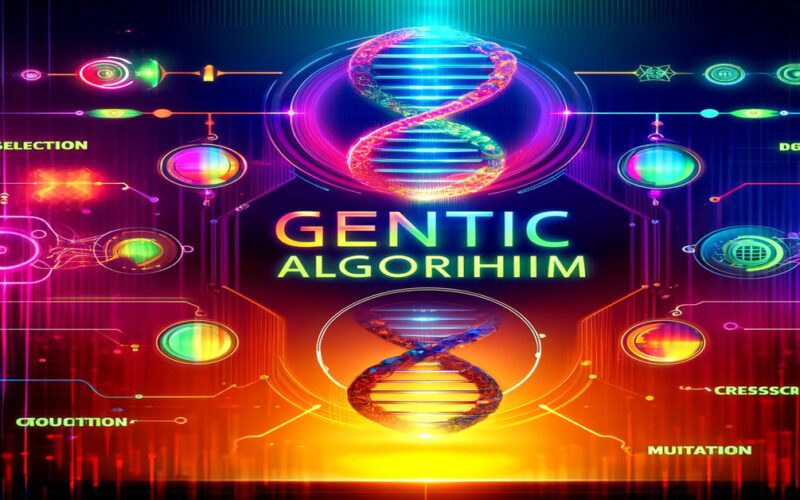Summary: Genetic Algorithm (GAs) are powerful optimization techniques that mimic natural selection to solve complex problems. By evolving a population of potential solutions through processes like selection, crossover, and mutation, GAs effectively explore vast solution spaces. They are widely applied in fields such as finance, engineering, logistics, and artificial intelligence.
Introduction
Genetic Algorithm (GAs) are innovative optimization techniques inspired by the principles of natural selection and evolution. They are designed to solve complex problems by iteratively improving a population of potential solutions.
For instance, GAs have been effectively applied in various domains, such as optimizing supply chain logistics, where they help determine the most efficient routes for delivery trucks, significantly reducing costs and time. In finance, GAs assist in portfolio optimization by evaluating numerous investment strategies to maximize returns while minimizing risks.
Additionally, they have been utilized in engineering for designing robust structures that can withstand environmental stresses. According to a study, GAs can outperform traditional optimization methods in scenarios involving non-linear and multi-modal functions.
By mimicking biological processes like selection, crossover, and mutation, Genetic Algorithm continuously evolve solutions toward optimal outcomes, showcasing their versatility and effectiveness in real-world applications.
Key Takeaways
- Genetic Algorithms mimic natural selection to optimize solutions effectively.
- They operate through selection, crossover, and mutation processes.
- GAs are versatile and applicable across various industries.
- They excel in solving complex optimization problems.
- Future trends include hybrid approaches and real-time optimization techniques.
What Are Genetic Algorithms?
Genetic Algorithms are a subset of evolutionary algorithms, which are optimization techniques based on the mechanics of natural selection. The core idea is to evolve solutions to problems over successive generations. This process involves several key components:
- Population: A group of potential solutions to a given problem.
- Chromosome: An individual solution within the population.
- Genes: The parts or variables that make up a chromosome.
- Fitness Function: A measure that evaluates how good a solution is at solving the problem.
The algorithm starts with a randomly generated population of solutions and iteratively improves them through selection, crossover (recombination), and mutation.
How Does Genetic Algorithm Work?
Genetic Algorithms (GAs) are powerful optimization techniques inspired by the principles of natural selection and genetics. They are designed to solve complex problems by iteratively evolving a population of potential solutions. The process begins with a randomly generated population, where each solution is represented as a chromosome composed of genes that encode specific parameters.
Initialisation
The process begins with the initialisation of a population, which consists of a set of potential solutions (chromosomes). These solutions can be generated randomly or based on heuristics. The size of the population can vary depending on the problem being addressed.
Evaluation
Once the initial population is created, each individual is evaluated using a fitness function. This function quantifies how well each solution solves the problem at hand. The fitness scores are essential for determining which individuals will selected for reproduction in the next generation.
Selection
In the selection phase, individuals are chosen based on their fitness scores. Higher fitness values increase the likelihood of selection, simulating the “survival of the fittest.” Common selection methods include:
- Roulette Wheel Selection: Individuals selected based on their proportional fitness.
- Tournament Selection: A set number of individuals are randomly chosen, and the one with the highest fitness is selected.
Crossover
The crossover step involves combining pairs of selected parents to produce offspring. This process allows for the exchange of genetic material, creating new solutions that inherit traits from both parents. Common crossover techniques include:
- Single-Point Crossover: A random point on the parent organisms’ chromosomes chosen, and genetic material is exchange at that point.
- Two-Point Crossover: Two points are selected, and segments between these points are swapped between parents.
Mutation
To maintain genetic diversity and avoid premature convergence, mutation introduces small random changes to some offspring. This could involve flipping bits in a binary representation or altering values in other encoding schemes. Mutation helps explore new areas of the solution space.
New Generation
After crossover and mutation, a new generation formed from the offspring and some elite individuals (the best performers from the previous generation). This ensures that high-quality solutions preserved while allowing for exploration of new possibilities.
Termination
The algorithm repeats the evaluation, selection, crossover, and mutation steps for multiple generations until a termination condition is met. This could be reaching a predetermined number of generations or achieving a satisfactory fitness level.
By iteratively applying these steps, Genetic Algorithms effectively search for optimal or near-optimal solutions across various complex problems, from engineering design to financial modeling and beyond.
Applications of Genetic Algorithm

Genetic Algorithms (GAs) are powerful optimization techniques inspire by the process of natural selection. They have been successfully applied across various real-world domains, showcasing their versatility and effectiveness in solving complex problems. Here are five notable examples of genetic algorithm applications:
Financial Portfolio Optimisation
Genetic Algorithms widely used in finance to optimise investment portfolios. By evaluating numerous combinations of assets, GAs help investors maximise returns while minimising risk. For instance, GAs can adjust the allocation of funds among different stocks based on historical performance and market conditions, leading to more informed investment strategies.
Autonomous Vehicle Navigation
Tesla has integrated Genetic Algorithms into its self-driving technology to enhance the performance of its autonomous systems. GAs optimise the neural networks responsible for decision-making in real-time driving scenarios, allowing the vehicles to adapt to changing environments and improve safety and efficiency on the road.
Logistics and Supply Chain Management
Amazon employs Genetic Algorithms to optimise its logistics operations, particularly in routing and scheduling deliveries. By analyzing vast amounts of data, GAs help streamline order fulfillment processes, ensuring timely deliveries and efficient use of resources, which is crucial for maintaining customer satisfaction in e-commerce.
Engineering Design Optimisation
Autodesk utilizes Genetic Algorithms within its design software to assist engineers in creating optimal designs for mechanical components. GAs can explore various design parameters to find configurations that meet specific performance criteria, such as strength and weight, thereby enhancing product efficiency and innovation.
Dynamic Pricing Strategies
Uber developed an evolutionary optimizer using Genetic Algorithms to refine its dynamic pricing model. By analyzing historical ride data and real-time demand patterns, GAs help determine optimal pricing strategies that maximize revenue while ensuring a fair experience for customers during peak times.
Future Trends in Genetic Algorithms
The field of Genetic Algorithms is evolving rapidly with ongoing research. Future trends in Genetic Algorithms focus on enhancing their efficiency and adaptability. Innovations include hybrid approaches, real-time optimisation, and integration with AI technologies, paving the way for their application in complex problem-solving across diverse fields.
- Hybrid Approaches: Combining Genetic Algorithms with other optimization techniques (e.g., local search methods) enhances performance and helps escape local optima.
- Adaptive Algorithms: Developing self-tuning Genetic Algorithms that adjust their parameters dynamically based on performance feedback is an area of active research.
- Applications in Big Data and AI: As data grows exponentially, GAs will play an essential role in optimizing Machine Learning models and extracting insights from large datasets.
Conclusion
Genetic Algorithms represent a powerful tool in solving complex optimization problems by mimicking natural evolutionary processes. Their ability to explore vast solution spaces makes them invaluable across various domains, from engineering design to financial modeling. While they come with certain challenges, ongoing advancements promise to enhance their efficiency and applicability further.
Frequently Asked Questions
What Are Genetic Algorithms?
Genetic Algorithms are optimization techniques inspired by natural selection. They evolve solutions through processes like selection, crossover, and mutation over successive generations to find optimal or near-optimal solutions for complex problems.
What Are Some Common Applications of Genetic Algorithms?
Genetic Algorithms are used in various fields such as optimization problems, Machine Learning for feature selection, engineering design, game development strategies, and finance for portfolio optimization.
What are the Advantages And Limitations of Genetic Algorithms?
Advantages include global optimization capability and flexibility across different problem types. Limitations involve high computational costs, potential premature convergence on suboptimal solutions, and sensitivity to parameter settings.



